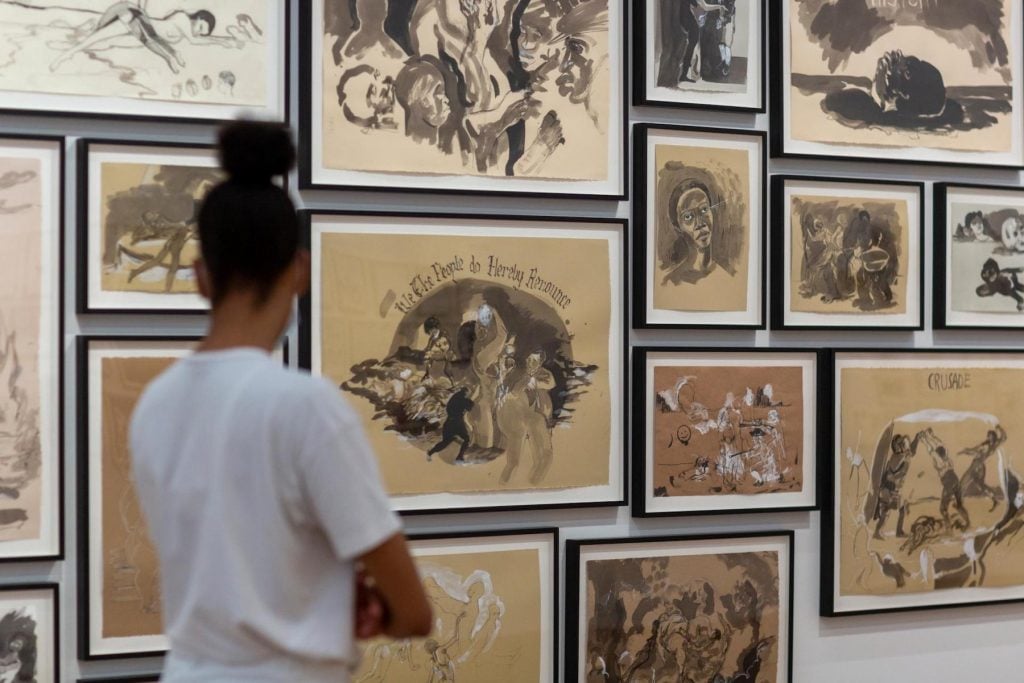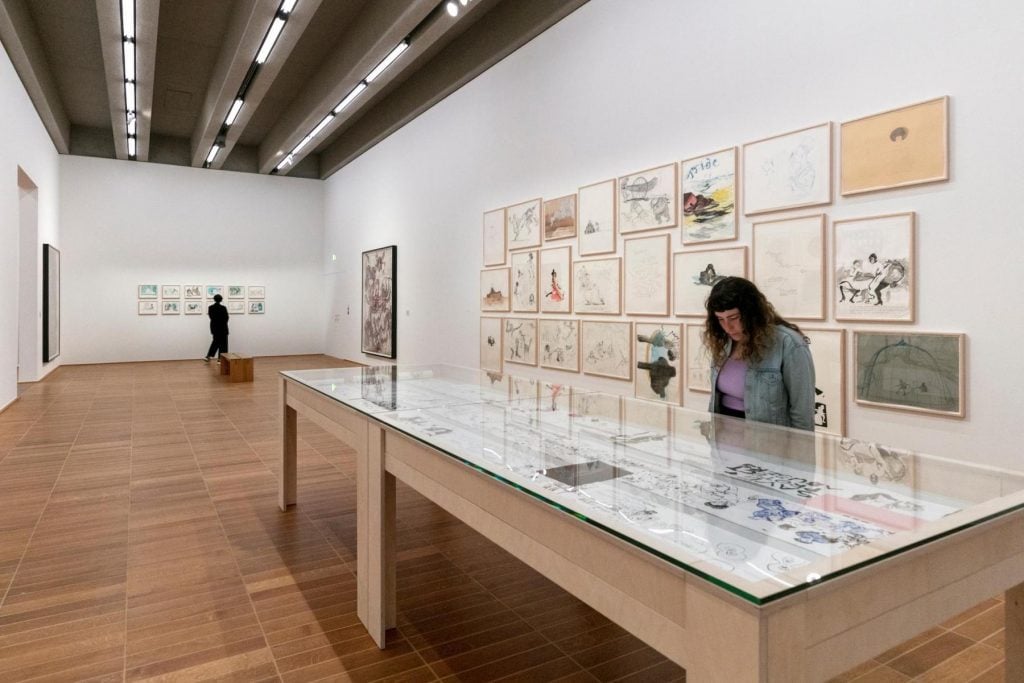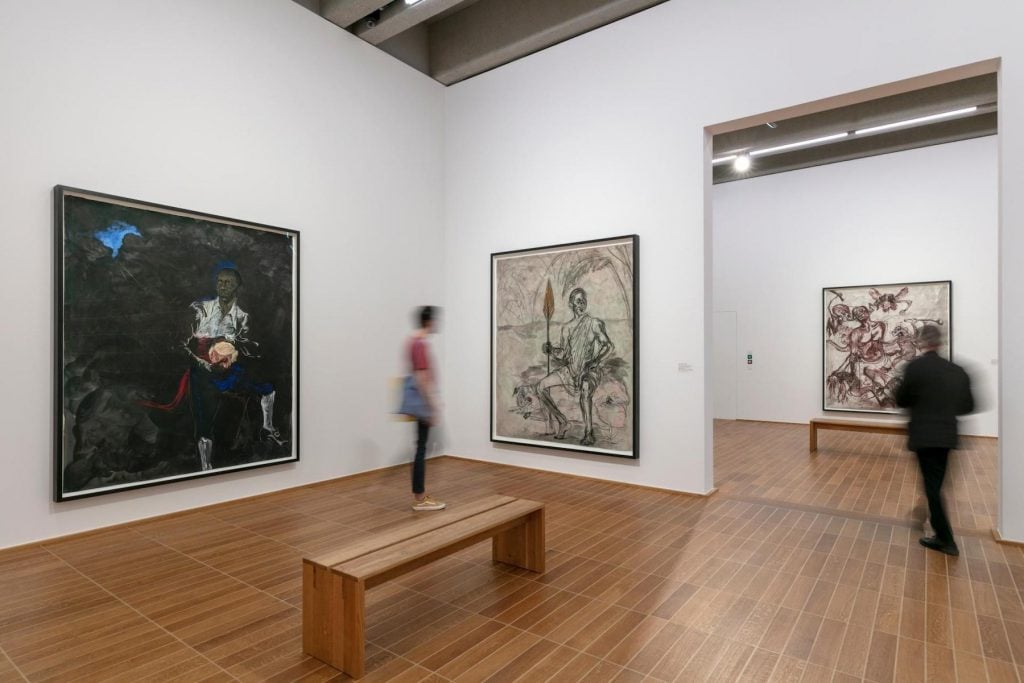Reviews
Kara Walker’s Museum Survey in Basel Is Difficult, Disturbing—and Very Necessary
“A Black Hole Is Everything a Star Longs to Be” at the Kunstmuseum Basel shows Walker's ability to keep her audience off balance.

“A Black Hole Is Everything a Star Longs to Be” at the Kunstmuseum Basel shows Walker's ability to keep her audience off balance.

Emmanuel Balogun

Black American contemporary painter, installation artist, silhouettist, print-maker, and filmmaker Kara Walker’s large-scale presentation of more than 600 works at the Kunstmuseum Basel in Switzerland reads as something like the excavation of masterworks from an artist’s mind. Assembling works from some 30 years, the survey is a grand collection of archival works, plans, inner thoughts, and dreams, and seems to be both an exhibition and an imaginative biography of a Black woman’s life over time. The show, titled “A Black Hole Is Everything a Star Longs to Be,” magnifies the United States’s realities of prejudice, perversion, and plunder, offering a taunting exposé of the racial, psychological, and (at times) psychosexual ties that bind and cut.
Across a broad assemblage of sketches, collages, newspaper clippings, handwritten notes, and confessions, Walker’s black pencil and deft ink strokes blur the spectator’s capacity to decipher which figures represent races, Black, white, or biracial. This blurring is symbolically important: One could say that she depicts descendants on both the right or wrong side of slavery, both the protagonists and the antagonists—but not necessarily clearly arrayed on either side, but betwixt or in between. Her vignettes, scribbles, and typed tales narrate both the artist’s and viewers’ imagined stories of social subjugation, restitution, and emancipation, sprouting from her preoccupation with the unseemly psychic aspects of a racialized master/slave dynamic.
Walker’s critics would say that the deliberately controversial style of her art warrants questioning her position as a Black commercial artist. The fact that such images are favored by an unregulated art market might also provoke some ethical questions for gallerists and collectors. Such difficult questions emerge from the way that Walker’s work displays either an inability or a refusal to positively represent one race of people—a task Black artists are often assigned.
Instead, I believe Walker has carved a liberated path for herself and her career exactly by refusing to censor her mind for the prudishness of any audience’s eyes. Walker’s pattern of playing with expected tropes is unmatched. In this epic showcase, this proposition is perhaps most memorably demonstrated in the cathartic “Success and the Stench of Ingratitude,” her 2012 series where the artist reflects on BLACK ARTISTS I ASPIRE TO BE LESS LIKE (as a text embedded in the work states), offering a list: “broke,” “forgotten,” “taken advantage of,” “bitter,” “crassly-commercial,” “short-lived,” and so on.

Installation view of “Kara Walker: A black hole is everything a star longs to be” at the Kunstmuseum Basel. Photo by Julian Salinas, courtesy Kunstmuseum Basel.
Works within her series “Untitled” (2002-2004) and “Palmetto Libretto” (2012) embody the artist’s knack for mimicry and startling transposition of racially inspired violence. Throughout these series and in several other works by Walker, audiences find artworks depicting what seems to be sexual domination if not torture or abuse. In one image, a black mandingo and white woman appear to be locked in fierce intercourse within the bush. In another, a Black woman resembling the artist herself is drawn, tired-eyed, day-dreaming of an orgy scene featuring white men with disfigured bodies, one notably armed with a nose resembling a male’s member, molesting a handcuffed Black woman who resembles the character Mammy, played by Hatti McDaniel in Gone with the Wind. In other works, characters with white masks, akin to the Klu Klux Klan, maraud as they haunt the night.
With such images, Walker creates a form of art that is alarming to both Black and white folk, besmirching the hierarchical and archetypal roles that persist in American popular culture and folklore. Her practice deliberately exaggerates images of orientalist desires and Black minstrels. Stereotyped Black body parts such as big lips, hips, and dicks persist. Yet I read Walker’s themes of sadomasochistic lust and fascination with interracial sex, domination, and submission, with their mix of grief, pleasure, and guilt, as actually a way to claim a sense of strength—by decimating one-dimensional narratives of power.

Installation view of “Kara Walker: A black hole is everything a star longs to be” at the Kunstmuseum Basel. Photo by Julian Salinas, courtesy Kunstmuseum Basel.
I’d argue that the key to Walker’s hold over her audience is the alternation of conditions of control. In some works, slavers enjoy power by inflicting entrapment, shame, and disgrace. In others, Walker creates dreamscapes where Black characters are desired, courted, and return the favor of racially inspired violence to white figures, seemingly both deserving and undeserving. Facing this kind of manipulation of the imagery of racialized or gendered domination and fetish, the spectator—whether the ancestor of a victim or perpetrator—is both enthralled and shamed by Walker’s heinous sketches of fantasies known to exist, but restricted to private life.
A surface-level encounter with Walker’s work can offend the untrained eye. But by a deeper interaction, we might see the invention of a new constellation of thought about race, power, gender, sex, and violence. This artist’s ability to collapse definitions, boundaries, and inherited associations might unlock a new route to taking control over narratives that we can, in fact, have autonomy over.
“Kara Walker: A Black Hole Is Everything a Star Longs to Be” is on view at the Kunstmuseum Basel, through September 26, 2021.